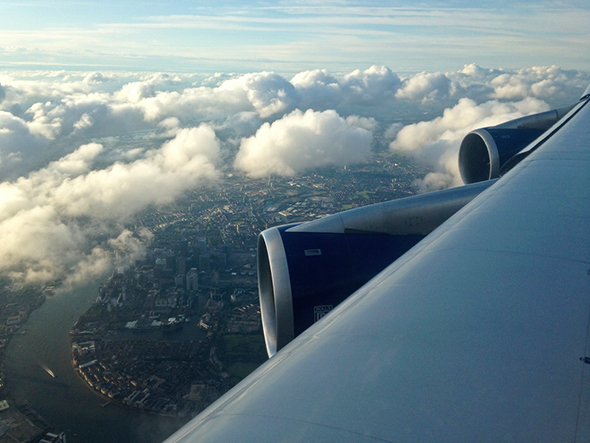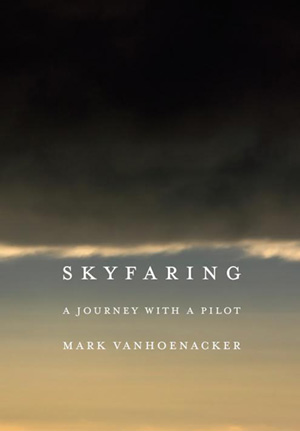The World, Collapsible
The most absurd and wonderful perk of piloting.

Photo by Mark Vanhoenacker
All week, Mark Vanhoenacker will be sharing stories about piloting and planes excerpted from his book Skyfaring: A Journey with a Pilot. Out now from Knopf.
A pilot may acquire an affectionate awareness of a kind of punctuation or asterisking of the world, composed of the names of small places, places that almost no one other than pilots will have reason to think of regularly.
Many geographic milestones are elevated this way because they are home to radio beacons. It’s hard not to think of older beacons, lit to help navigate, as with lighthouses, or to transmit warnings, as with the news of the sightings of the Spanish Armada, or to celebrate events such as coronations and jubilees. In the 1920s hundreds of light beacons, often placed high on mountaintops, inaugurated the first transcontinental airmail flights, from New York to San Francisco. This cross-country trail of light echoed the railroads, of course, but also the Pony Express, as pilots and planes would change en route, allowing letters to make an almost continuous journey from one coast to the other. There was even talk of a “lighted airway” across the Atlantic for dirigibles. Today, particularly in the western United States, some of the radio beacons used by modern airliners are sited just where those original light beacons once stood.
Near the tip of Cape Cod, Massachusetts, on the ocean side, stands a beacon that is a curiosity to those walking near the beach and that shares a name, appropriately, with Marconi, the Italian engineer known as the father of radio. Beacons like this one and the plane speak to each other, like children playing Marco Polo in a pool. The plane counts the time between its call of “Marco!” and the beacon’s reply of “Polo!” and so calculates the distance between them.
Pilots can manually tune a beacon and see our distance and bearing from it, a basic, old-school check of our position. But in the background a modern aircraft is always searching for them, like a driver in an unfamiliar town constantly seeking landmarks and street signs. Beacons have only a certain range, and when the aircraft finds one, its codes may flicker to life on one of our screens, and in this way we come to know the names of many of the beacons of the world.

The Slate staff’s questions about flying answered by British Airways pilot Mark Vanhoenacker.
In the more remote regions of the world beacons and airports often coincide; the beacon is there because the airport is there. When such a place is surrounded by nothing else that relates to aviation, its isolation lifts it into unexpected prominence in the sky. In Greenland is the airport named Aasiaat. It is on a bay I would like to visit one day, because it bears the marvelous name familiar to armchair atlas ponderers, long-haul pilots, and almost no one else: Disko Bay. The names of many small places in the far north of Canada have the quality of making bitterly cold water sound warmer than it can ever be—Pond Inlet, Sandy Bay, Hall Beach, and Coral Harbor.
Some beacons are in places that although famous are geographically incidental; you might not expect them to be elevated on aviation charts in a manner so independent of their historical prominence. Point Reyes is the name of a lighthouse on the Northern California coast; a beacon near it, known by the same name, features on arrivals in San Francisco. Robben Island, off Cape Town, South Africa, where Nelson Mandela was incarcerated, was a prison even in the 17th century. It’s home, too, to a beacon of the same name, which appears on charts for Cape Town’s airport and forms part of an often-used arrival pattern.
I have a Canadian friend from a small town in interior British Columbia. When I first asked where she was from, she laughed and shook her head and said I would not know it; it was a tiny town where they didn’t close the school unless the temperature was colder than minus 40 degrees Fahrenheit. But when she said the name of this small place, Williams Lake, it was my turn to smile and say: “I know Williams Lake; I gaze on it every few months. There’s a navigation beacon there.” When I see her, if I have flown over it recently, I will tell her if it was cloudy or if I could see her hometown resting between the Rockies and the Coast Range.
* * *
A pilot’s awareness that the whole world is possible is most acute when on standby. Sometimes these standby duties take place at airports, but often they are assigned at home, where we are required to be reachable by telephone and to be within a certain travel time of the airport. When another pilot cannot make it to work—illness, a child-care problem, a flat tire—then a standby pilot is called. Sometimes by the time I reach the airport the passengers have already boarded, the fuel and cargo are loaded, and staff are standing by the airplane’s last open door, waving their hands at an oblique angle that suggests both a greeting and the direction in which I should keep moving, through the airplane door that they will close as soon as I pass through it.
When I’m on standby I have a bag permanently packed, with both winter gloves and a bathing suit amid the uniform shirts, a bag for all lands, all seasons. I’ll be at home cleaning or at the supermarket or running in the park when my phone will ring and a voice tells me that I’m bound for Bangkok or Boston or Bangalore, India. I return home, pick up my bag, and fly there.
Occasionally I think that the more broadly you wish to experience the world, the more certain it is that you would enjoy being a pilot, even if flying itself isn’t your first love. Alfred de Musset, in a sonnet dedicated to Victor Hugo, wrote that in this “low world” you should love many things, in order to know at the end the thing you love best.
He lists some things we might love. He includes the sea and the blue of the heavens, and few pilots would disagree. But a pilot might also take the “low world” more literally. If you are interested in motorcycling or urban design, opera or kite surfing, hiking or languages, the whole world of these things opens to you, at least on long-haul trips, where even if you are able to fall asleep for the half day after arrival and before departure, you often have an entirely clear day or two in between. In many cities—Bangkok, Mexico City, Tokyo—cooking schools offer short courses that are popular with pilots and cabin crew, an opportunity to ground ourselves in the tastes of a new place and to do the cooking that a life of hotels and restaurants cuts us off from. Sometimes everyone at such a class works for one airline or another, sharing a few hours and a table in a far place.
Many of the pursuits that fill our off-duty hours are aligned with the natural world. I have flown with pilots who explore botanical gardens wherever they go or put time changes to good use by rising early to photograph sunrises. If you have an interest in wildlife, you will have the opportunity to see pandas or elephants or tigers or whales where they live or to see birds in one season and continent and then later in another; to overfly their migrations and wait for them somewhere else. You might read a book about the great trees of the world and a few years later have stood under many of them in their original habitats.
I don’t mean to diminish the many challenges of the job—the initial training costs that burden most new pilots with home mortgage–sized loans; the days and nights and holidays so far away from family and friends; the irregular schedules that make regular commitments to neighbors or local sports teams or community organizations so challenging; the permanent regimen of biannual, multiday simulator exams; the physical stresses of unpatterned night shifts, time-zone changes, and other circadian upheavals; and the knowledge that our livelihood can vanish entirely in the furrowing of a doctor’s brow during one of our regular medical checkups. Flying is work in every sense. (“The reason you fly,” admonishes the father of Jonathan Livingston Seagull, “is to eat.”) But there are few jobs, I think, whose side rewards are so varied—as wide as the whole world—and so freely determined by the individuals involved.
One of my own interests when I am away for work—downroute, as we say—is hiking, which seems to help with both place lag and jet lag, although whether this effect is due to the exercise or the simple act of placing my boots on the soil, I do not know.
I’m walking in a park in South Africa; it is hot and dusty; I am here with several of the flight attendants and the pilots. The soil is red, and the sky is blue; we are sleepy, but the sun and conversation keep us awake. It was nearly freezing when we left London last night; overcast, late autumn, the anti-icers running on all the engines for takeoff. Dawn came over Botswana, and as we descended together toward Johannesburg a few hours ago, we saw this land below, this color, smoothed to perfect abstraction and running to the horizon as the sun rose on this spring morning in southern Africa. Now I’m walking on the land we crossed over. This soil gusts up in small crimson clouds with each step of mine that falls on it. A colleague points to a tree, to a weaver nest hanging from a branch; he tells me that the birds are named for their skill in making these nests.
It’s four days later. I’m at home, standing sleepily by the sink. The water runs over the soles of my sneakers, sweeping the African dust brightly over the stainless steel. I have to say it in my head, practically spell it out: “This is the red of the soil under the South African tree, from the morning I saw the weavers and their nests.” People become quickly accustomed to peculiar aspects of any job. I try hard to remember that this is an unusual experience of the world—to have stood on the earth there, then there on it and there, then suddenly to find myself alone on an ordinary afternoon, quietly washing it from my shoes.
Also in Skyfaring:
Excerpted from Skyfaring: A Journey with a Pilot by Mark Vanhoenacker. Copyright © 2015 by Mark Vanhoenacker. Excerpted by permission of Alfred A. Knopf, a division of Random House LLC. All rights reserved. No part of this excerpt may be reproduced or reprinted without permission in writing from the publisher.
Listen to Julia Turner talk to Mark Vanhoenacker on Slate’s Working podcast:
